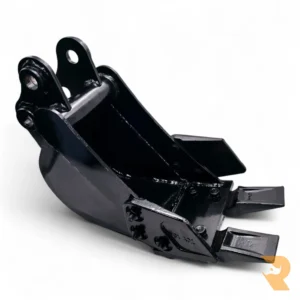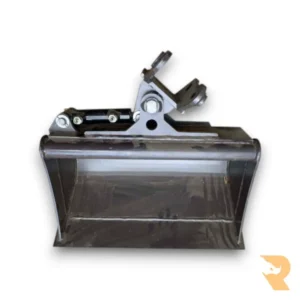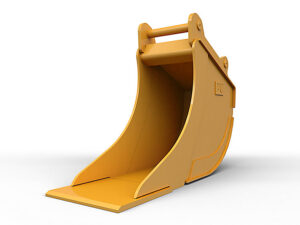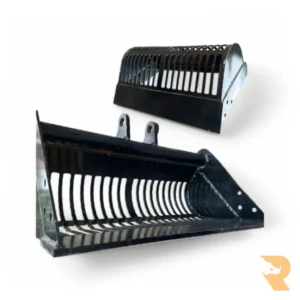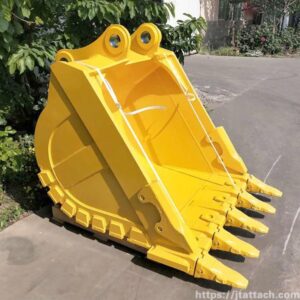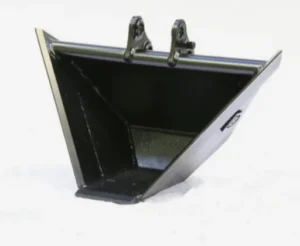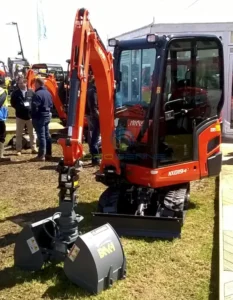Should You Add Another Bucket To Your Arsenal?
Whether you’re trenching for utilities, reshaping a garden slope, or preparing topsoil for turf, all of these can be done with a bucket. With so many bucket types on the market, having a better understanding of them will help you decide if getting another is the right decision for you to maximise the efficiency and versatility of your mini excavator. We will look at the top 7 types.
1. General-Purpose / Standard / Digging Bucket
The name speaks for itself! This bucket is the one that everyone knows, and everyone should have. It features teeth on the bucket, which help it penetrate surfaces and dig into the ground. A digging bucket is excellent for digging rough holes and moving topsoil. However, the standard bucket is not great at excavation when there is more compact or rockier soil.
2. Grading or Tilt Grading Buckets
Also known as a dyking bucket, finishing bucket or ditching bucket. “The smooth operator” bucket features a flat, smooth surface and a moderate scoop ─ for precise levelling and finishing of surfaces. The grading bucket doesn’t dig; it refines. Use it to level, spread, and polish your masterpiece. It’s not just for landscaping; most projects require flat surfaces, and a grading bucket also allows you to backfill easily. The wider, shallower profile ensures easier usage in tight spaces and greater efficiency with fewer passes required to move dirt, gravel, and sand across a site. Because they are so helpful, they are part of the three buckets that come with any of our rhinoceros excavators (200mm digging, 300mm digging, and 500mm grading buckets). However, grading buckets are not suitable for large-scale excavation due to their lack of teeth, making them inefficient for hard digging.
If you are willing to spend a bit more, adding a tilting feature allows for greater precision in grading and shaping surfaces, especially for creating slopes and contours, without needing to reposition the excavator as frequently. These are usually adjustable up to 45° and are perfect for landscape sculpting.
3. Trenching Bucket
Slimmer fit, deeper dig ─ this bucket is designed narrow and elongated, specially used for excavating small trenches: pipes, cables, irrigation lines, you name it. The bucket is lighter, making precise digging easier. Enables operators to dig to the required depth without over-excavation, in a clean, narrow shape. You can also get a micro-trenching bucket if very narrow trenches are needed. This is a must-have for precise trenching work.
4. Riddle Bucket (Skeleton/Shaker)
A riddle bucket, also known as a skeleton bucket or shaker bucket, features tines/ribs running through the middle, with gaps between them that allow dirt to fall through. At the same time, larger rocks, debris, and other materials are retained in the bucket. This allows you to strip the group of vegetation such as grass and small roots, as well as remove larger rocks or rubbish from the dirt, giving you a perfect topsoil for planting or turf installation. This is also great for preparing a stable base before building, such as laying foundations. They are also used to quickly separate reusable materials such as concrete and brick on demolition sites, or different types of waste, helping with recycling. They may come with teeth to help with ripping up vegetation and roots (sometimes called a rake riddle bucket) or may be similar in shape to a grading bucket to give a smooth finish.
5. Heavy-Duty or Rock Bucket
If the ground is tougher, a ripper tooth, a heavy-duty bucket, or a rock bucket is needed. When Mother Nature says no, this bucket says “try me.” Armed with high-strength wear-resistant steel, a thick body and reinforced teeth, this bucket is capable of withstanding rocks, gravel, cohesive soils, and most other things that pretend to be unbreakable. This is great for rocky and gravel soils construction (i.e quarries and heavy earthwork projects). For frost in particular, you can use a frost/hardpan bucket instead.
Why not always only use a heavy-duty bucket rather than a standard bucket? Not only is this bucket more expensive, it is also much heavier and therefore will reduce efficiency. Tip: not all heavy-duty or rock buckets are made equal. Check if it’s made for slightly rocky surfaces or the most demanding jobs in rocky material, depending on your needs.
6. V-Bucket
These trapezium-shaped buckets dig ‘V’ shapes into the ground, as the name suggests. Why would you want a ‘V’ hole? These are great for sloped drainage trenches with optimal efficiency. Standard digging buckets are unable to achieve the clean, consistent slopes of V-ditching buckets. Because you are also removing less dirt, there is reduced material removal and enhanced efficiency. While you can use them for laying pipes, utility lines and more, it’s more common to use the standard trenching bucket discussed earlier.
7. Clamshell Bucket
This is a specialised bucket that features a two-hinged jaw, handling materials with accuracy and minimal spillage. It’s perfect for grabbing and lifting materials in tight settings. The shells often have teeth or a hardened cutting edge to aid in digging into hard materials. Designed for vertical excavation in confined or deep spaces, and site cleanup.
Summary
It’s common for operators to have multiple buckets available for specialised purposes. The right bucket can cut your job time in half – treat your mini digger like the true jobsite MVP it is.
You should evaluate your project requirements, ground conditions, and mini excavator capacity to determine if a different bucket type would enhance your capabilities and productivity. Make sure to also consider the dimensions of the bucket you are using, as not all buckets of the same kind are built the same.
Overall, here’s our quick take:
| PROJECT TYPE | BEST BUCKETS |
|---|---|
| General digging? | Go for: General-purpose, Heavy-duty |
| Trenching? | Go for: Trenching, V-Bucket |
| Landscaping / Grading? | Go for: Grading, Tilt |
| Debris sorting or Preparing Soil? | Go for: Riddle/Riddlerake |
| Vertical Excavation? | Go for: Clamshell |
